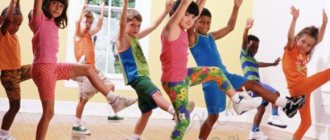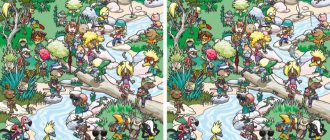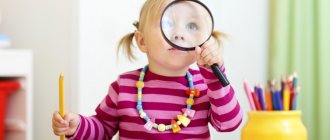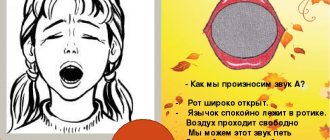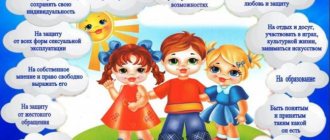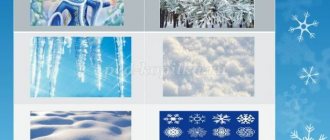Physical exercises
In the swamp In the swamp, two girlfriends, two green frogs, washed early in the morning, rubbed themselves with a towel. They stomped their feet, clapped their hands, leaned to the right, to the left, and came back. That's the secret of health. Hello to all physical education friends! (Children accompany the reading of the poem with movements.)
Swifts fly over the water Swifts fly over the water, (Hands to the sides.) Ruffs float under the water, - (Squat down.) A beautiful boat floats - Painted sails. (Hands clasped in front of the chest, smooth movements of the body.)
It's frosty outside. It's frosty outside. To keep your nose from freezing, you need to stomp your feet and clap your palms. (Children slap their hands on their shoulders and stomp their feet.) Now let’s imagine summer. The river is warmed by the sun. We swim, swim, swim, reaching the bottom with our feet. (Swimming movements with hands.) We leave the river and head to the edge. (Walk in place.)
We bend over with a clap. We bend down with a clap. And with a clap we then get up. Down and up, down and up, Come on, clap the loudest! (Bend over and clap your hands below, straighten up and clap above your head.) On one leg we jump, Like an elastic ringing ball. Let's jump to the other one too. We can jump for a very long time. (Jumping on one leg.) Rotate your head smoothly, Look left, look right. (Turn your head right and left.)
Flowers grow in the meadow Flowers grow in the meadow Of unprecedented beauty. (Stretching - arms to the sides.) Flowers are reaching towards the sun. Stretch with them too. (Stretching - hands up.) The wind blows sometimes, But it’s not a problem. (Children wave their hands, imitating the wind.) The flowers bend down and lower their petals. (Bends over.) And then they get up again And still bloom.
On the lawn in the morning On the lawn in the morning We started a game. You are a daisy, I am a bindweed. Stand in our wreath. (Hold hands and form a circle.) One, two, three, four, move the circle wider. (Walking in a circle.) And now we are streams, Let's run in a race, (Running in a circle.) We're rushing straight to the lake, The lake will become big. (Walking in a circle.) One, two, three, four, move the circle wider. Stand in a circle to play. We are the cheerful rays. We are frisky and hot. (Jump in place.) One, two, three, four, move the circle wider. One, two - bend forward! (Bend forward.) Three, four - a little faster! Rise up, pull yourself up, (Bend over, arms up.) Then take a deep breath. One, two - bend back, do not bend your knees at all. One, two, three, four, swing your arms, spread your legs! (Waving your arms.) One, two, three, four, five! (Jumping in place.) They started running and jumping!
We can’t sit still We can’t sit still, Let’s stretch our lower back. We twist the body left and right - So we will have a great rest. (Rotation of the body.) We had a good rest and returned to classes. (Children sit down.)
It's time for us to take a break It's time for us to take a breath, Stretch and breathe. (Deep inhale and exhale.) Turn your head, And away is all the fatigue! One-two-three-four-five, You need to stretch your neck. (Rotate your head in one direction and the other.) Stand up straight. They leaned over. One - forward, and two - back. We stretched ourselves. Straightened up. We repeat everything. (Bend forward and backward.) And then we squat. This is important, we know it ourselves. We stretch our knees, We exercise our legs. (Squats.)
Physical education minute. We stand on one leg. We stand on one leg. We want to stay that way. We raise our arms up and calmly lower them. (Children stand on one leg, raise straight arms through the sides, then lower them through the sides and repeat the same on the other leg.) Everyone is tired of sitting. We want to move the Corps back and forth. Both useful and pleasant! (Rotate your body to the right and left.) And then you and I will twist our heads to our heart’s content. (Rotate head.) And they sat down again, Let's get down to business. (Children sit down.)
At the parade Like soldiers at the parade, We walk row by row, Left - once, left - once, Look at us, everyone. Everyone clapped their hands - Together, have fun! Our feet pounded louder and faster! (Walk in place.)
In a clearing there is a green oak tree. In a clearing there is a green oak tree, its crown reaching towards the sky. (Stretching - hands up.) He generously hung acorns on the branches in the middle of the forest. (Stretching - arms to the sides.) And below there are mushrooms growing, There are so many of them here today! Don't be lazy and don't be shy, lean over for mushrooms! (Bends forward.) Here the frog jumped, Here, apparently, there is not enough water for it. And the frog cheerfully jumps straight to the pond, no less. (Jumping in place.) Well, we’ll walk a little. Raise your leg higher! (Walk in place.) We walked around, frolicked, and sat down on the grass!
In the clearing there is a mighty cedar. In the clearing there is a mighty cedar. It touches the clouds with its crown. A pine tree grows next to him, it reaches towards the sky. (Standing on the right leg, we stretch our arms up, then the same on the left.) We are looking for mushrooms below and diligently searching in the grass. One - fungus and two - fungus, Put them in the box. (Lean forward and touch your left foot with your right hand, then vice versa.)
Get ready to warm up Get ready to warm up! Spin right and left Count the turns, One-two-three, don’t lag behind, (Rotate the body to the right and left.) We begin to squat - One-two-three-four-five. The one who does the exercises can do a squat dance for us. (Squats.) Now let’s raise our arms and lower them with a jerk. It's like we're jumping off a cliff on a sunny summer day. (Children raise straight arms above their heads, then lower them with a sharp movement and move them back, then with a sharp movement up again, etc.) And now walk in place, Left-right, stand once or twice. (Walk in place.) We will sit on the mat together, and get down to business again.
Pump And now we turn on the pump, we pump water from the river, to the left - once, to the right - twice, water flows in a stream. One, two, three, four - (3 times.) We did a good job. (Tilt to the right, the left hand slides up along the body (to the armpit); tilt to the left, move up with the right hand.)
Jump onto the path! - frog Jump on the path! - frog. Where are you in a hurry, frog? Jump off the hummock! Jump on the bump! Splash into the water! Kick your legs! (Jumping in place.) Here the hedgehog walks calmly, carrying a mushroom on needles. He passes under the bushes and rustles behind the burdocks. (Walk in place.)
Warm-up begins Warm-up begins. We stood up and straightened our backs. They leaned left and right and repeated again. (Tilts to the sides.) We squat in a row, One-two-three-four-five. This is a necessary job - to train the leg muscles. (Squats.) And now we perform arm jerks together with you. (Jerks with arms in front of chest.)
Our scarlet flowers Our scarlet flowers Bloom their petals. (Smoothly raise our hands up.) The breeze breathes slightly, the petals sway. (Swinging arms left and right.) Our scarlet flowers Close their petals, (Squat down, hide.) Shake their heads, (Move their heads left and right.) Quietly fall asleep.
Don't rush, don't lag behind! Legs apart, hands on waist. We need to stretch our backs. Let's bend over, come on, don't rush, don't lag behind! (Tilt to the sides and forward.) Turn the mill forward: One, two, three, four, five. And then vice versa We will rotate the mill. (Rotate with straight arms forward and backward.) Pull your knee to your chest and stand for a while. Learn to maintain balance. (Raise your legs bent at the knees as high as possible.)
New Year (Children, holding hands, form two circles and read a poem.) Everyone has a New Year, And we have a New Year. (They take a step with a stomp and simultaneously clap their hands, turning to the right and to the left.) Near the green Christmas tree (Both circles move around the tree in different directions.) Round dance, round dance. Santa Claus has come, Santa Claus has come to us. (Continuing to hold hands, they make slight tilts of their heads in different directions, as if telling each other this news.) He brought us toys, and firecrackers, and sweets! (They spin around in place, raising their arms and rotating their hands.) He is kind with us, He is cheerful with us,— (They take a step with a stomp, clap at the same time, turning in different directions.) Near the green Christmas tree He himself went to dance with us. (Holding hands, they walk in two circles in different directions.)
Physical education minute. Legs Where, where are our legs? Where are our legs? Where, where are our feet? Our legs are missing. (Squatting, cover your legs with your hands.) Here, here are our legs. Here are our legs. Our feet are dancing, our feet are dancing, our feet are dancing. (Repeat different movements of the dancer.)
Feet Let's clap our hands, Let the feet dance, Let the feet dance Along the level path, Along the level path. Our legs are tired, Our legs are tired. This is our home, where we live. Cross your legs - get down and wait for the command. And when I say: “Get up!” - Don’t help them with your hand. Legs straight, legs apart, Legs together, legs askew. Legs here and legs there. What is this noise and what is this commotion? (Children accompany all words with movements.)
Physical education minute. Well, the snow is flying and flying. The fir trees are standing outside the window, looking into the blue sky. (Stretching - arms up.) The branches stick out to the sides, (Stretching - arms forward.) Squirrels are sitting on the branches. (Children sit in a deep squat for a few seconds, then stand up.) Squirrels jump on Christmas trees, Squirrels collect cones. They are not afraid of needles - Squirrels are clever little ones. (Jumping.) We sit under the Christmas trees and look at the squirrels. (Sit down.) The wind blows icy (Children wave their hands.) And raises a cloud of snow. He is harsh and powerful. (Children twirl their hands.) Hares are hiding in the bushes. Even the sly fox Hides and sits, (Children sit in a deep squat for a few seconds, then stand up.) Well, the snow flies and flies. (Children wave their hands.) But the evil blizzard subsided, and the whole area became white. (Stretching - arms to the sides.) The sun is shining in the sky. (Stretching - arms up.) A fox gallops across the field. (Jumping.) Well, we’ll walk a little (Walking.) And we’ll return home to our place. (Children sit down.)
Come on, bunny, jump. Come on, bunny, jump. With your paw, with your paw, knock, knock. You fall on the grass, fall, lie down and rest. You've rested, now get up and start jumping again! Run quickly to the Christmas tree and jump back quickly. (Children jump on two legs, clasping their hands to their chest, imitating the movements of bunnies. Then they squat down and rest. They get up and jump again. At the teacher’s command, they run quickly to the “Christmas tree”, and then scatter to their places.)
Come on, the birds, they flew, Come on, the birds, they flew, They flew and sat down, They pecked some grains, They played in the pole, They drank some water, They washed their feathers, They looked to the sides, They flew away. (Walking turning into running.)
Summary of the lesson “Water in human life.” Preparatory group
Summary of educational activities for familiarization with the outside world in a preparatory group for school on the topic “Water in people’s lives”
Description of the material : I offer you a summary of direct educational activities for children of a preparatory group for school (6-7 years old) on the topic “Water in people’s lives.”
This material will be useful to preschool teachers. The work is aimed at expanding preschoolers’ understanding of the role of water in human life and fostering a careful attitude towards water. It is conducted as a separate lesson to familiarize children with the world around them. Summary of direct educational activities in the preparatory school group on the topic “Water in people’s lives”
Integration of educational areas “Communication”, “Socialization”, “Cognition”
Goal To show the importance of water in people’s lives. Educational objectives: Expand understanding of the role of water in human life and its impact on health. Introduce the history and construction of water supply systems. Develop observation skills. Developmental tasks: to develop attention, memory, logical thinking. Educational tasks: To cultivate a caring attitude towards water. Demonstration material: Globe, audio recording of the noise of the sea, stream, apple, water purification scheme. Handout: two glasses, gauze, muddy water. Methodological techniques: conversation-dialogue, examination of illustrations, diagrams, conversations on them, physical exercises, experiment, analysis, summing up.
Progress of the lesson
Educator: Guys, listen, who is talking to you? (We listen to an audio recording of the murmur of a stream and the splash of sea waves) Children: Water. Right. People need water every day. A person can live without food for three months, but without water only a week. Why do people need water? Children: To drink, cook food, wash hands, dishes, floors, do laundry, water houseplants. Educator: Yes, people need a lot of water. And not only to quench your thirst and keep yourself and your home clean. Water is needed for washing streets and cars, for factories and factories, for watering vegetable gardens, orchards, and fields. To make one ton of paper, you need to use 250 tons of water, and to make one ton of steel, steelmakers need 150 tons of water. This is how much water is needed for production. Guys, look at the globe. The blue color here represents water. Is there a lot of water on Earth? Children: A lot. Educator: Yes. If we imagine an apple as our planet and cut it into four parts, then 1 part is land, and the remaining 3 parts are water. That's how much water there is on Earth. But most of the water is salty. The water in the oceans and seas is salty and cannot be drunk. You can drink fresh water, it is found in rivers and lakes. — Look at the globe and compare how many fewer fresh water bodies there are on Earth. This is why water must be conserved. Fizminutka And above the sea - you and I! Seagulls are circling above the waves, Let's fly after them together. Splashes of foam, the sound of the surf, And above the sea - you and I! (Children flap their arms like wings.) We are now sailing on the sea And frolicking in the open air. Have fun rowing and catch up with dolphins. (Children make swimming movements with their hands.) In the old days, cities and villages were built along the banks of rivers. Educator: Why do you think? (Children's answers) Because at that time there was no running water. In those distant times, people took water from rivers and lakes. The water in the reservoirs was clean, you could drink river and lake water. To make it even cleaner and tastier, rowan leaves were placed in vessels with water. They not only purified the water, but also gave it a unique taste. There were a lot of fish in the rivers and lakes. Many peasants were engaged in fishing. They not only cooked fish soup, but also salted, dried, and dried it, i.e. prepared for future use. Ships walked along the rivers and these water roads. Merchants transported their goods from city to city and carried on trade. Century after century passed, the water in the rivers became more and more polluted as people built factories and factories. Waste from production was dumped into rivers. Therefore, drinking river water became increasingly dangerous. Dangerous diseases, such as typhoid fever, were carried with water. Cities grew, the population increased, people suffered from a lack of clean drinking water. Let's try to mentally transport ourselves to our capital 300-400 years ago. The water in the Moscow River was clean and transparent, and in the courtyard of every house there was a well with good water. Under Tsar Peter I, industry began to develop rapidly, polluting the soil, water, and air. It was then that outbreaks of epidemics began, people began to die from contagious diseases. Many more years passed, Tsarina Catherine II issued a decree on the construction of a water pipeline in Moscow. The water pipeline took 12 years to build. And they took water from the Mytishchi springs. Residents of Mytishchi were proud of their clean water. Since then, Muscovites have developed a tradition of drinking tea. This is how they wrote about tea drinking in those days: “At every hour, at every time of the year, a true Muscovite offers tea to every guest, so that in many houses they drink so much of it that you’ll lose count.” Now the Moscow water supply system is more than 200 years old. River water undergoes filtration and bacteriological purification and enters houses through underground pipes. Now look at what the plumbing looks like in the diagram. Water purification scheme
A pump transfers it from the river to a water intake. Then it goes into the mixer, where it is cleaned. Then it flows through the pipes into the sump. From it it enters the vessel, where it passes through filters. You and I can also purify water through a filter Experience in water purification In front of you is gauze and two glasses, one with water, the other empty. Pour the water through cheesecloth into an empty glass. What's left on the gauze? Children: All the dirt remained on the gauze. Educator: What did the water in the glass become? Children: Clean. Educator: Gauze is like a filter, it does not allow dirt to pass through, it retains it. And so you can pour the water through the gauze again, and it will be even cleaner. This is how tap water is purified, further along the pipe the water is poured into a tank with clean water, and only from here pumps pump clean water through water pipes to the city, to our apartments. This is how long it takes for water from the river to reach us. Many people work to help water travel this path. A lot of effort is spent to clean it. How should we treat water? Children: Carefully, wisely, economically, economically. Summary of the lesson What new did you learn? Educator: Where did people build their houses in the old days? Children: In the old days, cities were built along the banks of rivers. Educator: Where did people get drinking water? Children: In rivers, lakes Educator: Why has it become dangerous over time to drink water from rivers and lakes? Children: People began to pollute the water. Educator: How to purify water before supplying it to homes. Children: Through water purification systems. Educator: Can a person live without water? Children: Without water there is no life.
We recommend watching:
Lesson in the senior group of a preschool educational institution. Properties of water. Summary of the lesson “World Water Day” in the preparatory group. Summary of the lesson in kindergarten in the preparatory group. Patterns of Yakutia
Similar articles:
Summary of a lesson on cognition in the preparatory group. Family ties
Summary of a lesson on labor education in the preparatory group
Summary of a lesson on cognition in the preparatory group. Emotional state of people
Lesson notes for the preparatory group. What are houses for?
Lesson notes for the preparatory group. Earth is our common home
